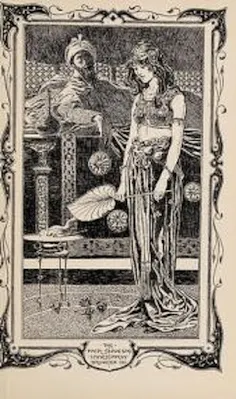Fairy tales from the Arabian nights
This book contains the best stories from Arabian Nights with Illustrations
Excerpt from the editor's preface
They are the best, too, of all those tales from Arabia, India, or China, if we measure them by the fame they have gained beyond their fellow stories in our Western world. They include “Aladdin and the Wonderful Lamp,” “ Sinbad the Sailor,” and others just as engrossing, which have been told more often to English youngsters than any stories in all the world’s ken, save those, like “Jack the Giant Killer” and “Tom Tit-Tot,” that are British or English and home-made. Perhaps to enjoy them in their full Arabian flavour, which is as pleasant and distinct to the taste like a cup of the best Arabian coffee, we ought to recall how in the tents, or in the narrow streets, of the East, the tale-tellers commonly tell tales of this kind. It is on the evenings of feast days and holidays that the tale-tellers in Arab towns and villages usually recite their tales.
You may picture them sitting on a stool, either on the floor of a tent or on the raised seat built-in some Eastern streets before the coffee shops. They sometimes have a musical instrument, a viol of only one string called the “ Poet’s Viol,” on which they play a note or a few notes where scrap or few lines of verse come, as they so often do, into the story. As for the hearers, they sit where they can, on the bench or on the ground, smoking their long pipes and sipping their coffee. The performer or tale-reciter is most lively in gesture and most expressive in voice when narrating the various events, alarm¬ ing or amusing, that make up the story; and he recites them, as a rule, only from memory. But there are a few tale-tellers in larger cities, like Cairo, who read stories also from books.
Contents of the book:
They are the best, too, of all those tales from Arabia, India, or China, if we measure them by the fame they have gained beyond their fellow stories in our Western world. They include “Aladdin and the Wonderful Lamp,” “ Sinbad the Sailor,” and others just as engrossing, which have been told more often to English youngsters than any stories in all the world’s ken, save those, like “Jack the Giant Killer” and “Tom Tit-Tot,” that are British or English and home-made. Perhaps to enjoy them in their full Arabian flavour, which is as pleasant and distinct to the taste like a cup of the best Arabian coffee, we ought to recall how in the tents, or in the narrow streets, of the East, the tale-tellers commonly tell tales of this kind. It is on the evenings of feast days and holidays that the tale-tellers in Arab towns and villages usually recite their tales.
You may picture them sitting on a stool, either on the floor of a tent or on the raised seat built-in some Eastern streets before the coffee shops. They sometimes have a musical instrument, a viol of only one string called the “ Poet’s Viol,” on which they play a note or a few notes where scrap or few lines of verse come, as they so often do, into the story. As for the hearers, they sit where they can, on the bench or on the ground, smoking their long pipes and sipping their coffee. The performer or tale-reciter is most lively in gesture and most expressive in voice when narrating the various events, alarm¬ ing or amusing, that make up the story; and he recites them, as a rule, only from memory. But there are a few tale-tellers in larger cities, like Cairo, who read stories also from books.
Contents of the book:
The King Of Persia And The Princess Of The Sea. I
Prince Camaralzaman And The Princess Of China. 1 8
Prince Camaralzaman And The Princess Of China. 1 8
The Loss Of The Talisman . . . -53
The First Voyage Of Sinbad The Sailor. 74
The Second Voyage Of Sinbad The Sailor. 78
The Third Voyage Of Sinbad The Sailor. 85
The Fourth Voyage Of Sinbad The Sailor. 91
The Fifth Voyage Of Sinbad The Sailor. 99
The Sixth Voyage Of Sinbad The Sailor. I05
The Seventh And Last Voyage Of Sinbad The Sailor Ii4
The Story Of Ali Baba And The Forty Thieves. 121
The Story Of The Enchanted Horse. 151
The Story Of The Fisherman And Genie. • I 75
The Story Of Aladdin Or, The Wonderful Lamp. 202
The Fair Slave Was Immediately Brought In. 3
Princess Badoura And Prince Camaralzaman . 29
“i Am An Astrologer” . . . -47
Prince Camaralzaman Discovers The Cave. 6l
“one Of Them Came To The Nest Where I Was ”. 8l
The Tavo Rocs Approached With A Frightful Noise Ioi
We Marched Thus Together . . . .ill
The Elephant Taking Me Up With His Trunk, Laid
Me On His Back . . . . . Il8
Ali Baba Counted Forty Of Them. *123
Morgiana . . . . . .141
The Prince Immediately Fell In Love With Her . 1 59
The Princess Of Bengal . . . .169
“i Say,” Answered The Genie, “speak To Me More
Civilly, Before I Kill Thee ” . . . 179
The Lady Overturned The Frying-pan... 185
The City Of The Black Isles . . . . I92
Aladdin’s Mother Was Unable To Speak. 217
New Lamps For Old .;251
44 Illustrations by, John Dickson Batten
Editor: E. Dixon
Publication Date: 1907
Publication Date: 1907
Publisher New York: G.P. Putnam's Sons
Download 24 MB - PDF ebook
Download 24 MB - PDF ebook

